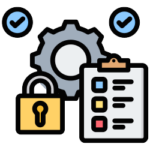
As a leader in healthcare, you face countless responsibilities—one of the most important being cybersecurity.
While it’s impossible to be 100% protected, you can focus on critical areas to make the most impact with the least amount of effort. This article outlines the top data security challenges healthcare organizations are facing and the practices that can help you confidently overcome them.
Sensitive Protected Health Information (PHI) is one of the most valuable pieces of information cybercriminals can get their hands on. Somebody can use it to blackmail, commit identity theft, and financial fraud. In healthcare, people’s lives are on the line, and cybercriminals can count on hospitals being willing to pay for the stolen data of their patients and restore operations to continue providing life-saving care.
Moreover, the financial and operational consequences of healthcare breaches are staggering. In 2023 (and for the 13th year in a row), healthcare data breaches were found to be the costliest, with the average cost of a breach increasing to $10.93 million. In more severe cases, breaches considered willful can lead to jail time—expenses that no organization can afford.
The healthcare industry has had to rapidly adapt to the need for online systems, cloud storage, and virtual patient care, making it difficult for cybersecurity to keep up. As a result, many networks, medical devices, and billing systems have been left vulnerable to cyberattacks.
However, by understanding and protecting your industries’ high-risk areas, you can and stay one step ahead of cybercriminals—keeping the data of your patients and practice safe.

Ensure Your Healthcare Organization Is Prepared
Ready to strengthen your cybersecurity defenses? Download our comprehensive Cybersecurity Readiness Checklist for Healthcare Organizations and take the first step toward protecting your critical assets. This checklist is designed to help you assess your current security posture, identify potential vulnerabilities, and implement best practices tailored to the unique challenges of the healthcare industry.
Healthcare Industry Tip: Partnering with an IT expert to assess and safeguard the following areas can help ensure your security plan meets healthcare-specific compliance standards and regulations.
With over 133 million patient records breached in 2023 alone, protecting electronic health records is critical. Electronic Health Records (EHRs) contain names, addresses, and other personal information, making them prime targets for cybercriminals. Once this data is leaked, it can be used to steal identities and commit blackmail.
For example, in the 2022 OakBend Medical Center data breach, cybercriminals hacked their computer system and exposed over 500,000 patient and employee records. It was a painful situation that could’ve been prevented if OakBend had proper EHR protections.
Healthcare networks are more exposed than other industries due to the need for patient access and interactions with third parties like vendors, suppliers, and support contractors. These connections create multiple entry points for potential breaches. The Internet of Medical Things/Devices (IoMT) is a prime example. These devices transmit, collect, and analyze medical data over a hospital’s network. Common IoMTs include fitness trackers, ECG monitors, glucose monitors, pacemakers, and defibrillators.
Since these devices rely on network connectivity (often 24/7), any instability in the hospital network or lack of data encryption creates easy access points for hackers.
Since the rise of virtual care, millions of devices—acting as entry points—are utilizing public and private networks to share sensitive patient information. If these networks, the devices themselves, and users aren’t properly educated on cybersecurity best practices, it can put large amounts of data at risk.
Hospitals and healthcare practices transmit vast amounts of billing information each day. As this information moves across networks, criminals can use malware to spy and silently gather data in your billing and claims management systems (CDSS). Once they have enough information, they’ll strike or make their presence known. The 2019 AMCA data breach affected nearly 20 million patients, exposing billing information due to system vulnerabilities and resulted in the AMCA filing for bankruptcy protection.
Taking proactive steps to secure your data can significantly reduce risk and protect your healthcare organization’s critical assets. Thankfully, you don’t have to do it alone. For 30 years, IT Solutions has provided comprehensive network support and security for healthcare organizations of all sizes. Our entire team, from help desk engineers to office staff, is trained in HIPAA and PCI security best practices, ensuring you receive industry-focused, compliant solutions.
Contact ITS today to strengthen your defenses and secure your healthcare organization’s future.
We’ve got answers — fast, clear, and tailored to your needs. Let’s talk tech.
